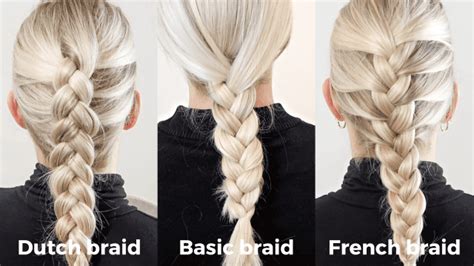Introduction
The allure of braids has captivated hair enthusiasts for centuries, offering endless possibilities for elegant and intricate hairstyles. Among the most popular and timeless braiding techniques are the Dutch braid and the French braid, each boasting unique characteristics that set them apart.

Understanding the Dutch Braid
The Dutch braid, also known as an inverted French braid, is a captivating technique that creates a stunning raised effect. The braid begins at the crown and gradually works its way down the hair, with each strand interwoven in an underhand motion. This technique elevates the braid, adding volume and dimension to any hairstyle.
Exploring the French Braid
The French braid, a classic and versatile technique, is renowned for its intricate and sophisticated appearance. It involves repeatedly crossing three strands of hair over one another, with each section incorporated from the sides as the braid progresses. The result is a flat, elegant braid that exudes timeless beauty.
7 Key Differences between Dutch Braid and French Braid
- Height: Dutch braids are known for their raised height, while French braids lie flatter against the head.
- Starting Point: Dutch braids start at the crown of the head, whereas French braids can be started from any point along the hair’s length.
- Strand Overlaying: Dutch braids involve underhand strand overlaying, creating a raised effect. French braids utilize overhand strand overlaying, resulting in a flatter appearance.
- Volume: Dutch braids naturally add volume to the hair, while French braids tend to maintain a less voluminous silhouette.
- Complexity: Dutch braids require slightly more skill and practice to master than French braids.
- Suitability for Hair Types: Dutch braids are suitable for all hair types, but they are particularly flattering on fine hair as they create the illusion of fullness. French braids are appropriate for most hair types, but they may be more challenging for very fine or slippery hair.
- Visual Impact: Dutch braids make a bold and dramatic statement, while French braids convey a more delicate and sophisticated allure.
A Step-by-Step Guide to Braiding
Dutch Braid
- Gather a small section of hair at the crown.
- Divide it into three equal strands.
- Cross the left strand over the middle strand.
- Cross the right strand over the new middle strand (now the former left strand).
- Gather a small section of hair from the left side and add it to the left strand.
- Cross the left strand, now with the added hair, over the middle strand.
- Repeat steps 5 and 6 with the right strand.
- Continue braiding until you reach the desired length.
- Secure the braid with a hair tie.
French Braid
- Gather a small section of hair near the crown.
- Divide it into three equal strands.
- Cross the left strand over the middle strand.
- Cross the right strand over the new middle strand (now the former left strand).
- Gather a small section of hair from the left side and cross it under the left strand.
- Cross the new left strand over the middle strand.
- Cross the right strand over the new middle strand (now the former left strand).
- Repeat steps 5 and 6 with the right strand.
- Continue braiding until you reach the desired length.
- Secure the braid with a hair tie.
Pros and Cons of Dutch Braid vs. French Braid
Dutch Braid
Pros:
* Creates volume and height
* Visually striking
* Suitable for all hair types
Cons:
* More challenging to master
* May not be as suitable for very long or thick hair
French Braid
Pros:
* Classic and elegant
* Versatile and sophisticated
* Relatively easy to learn
Cons:
* May not create as much volume as a Dutch braid
* Not as suitable for very fine or slippery hair
Innovative Applications for Braiding Techniques
The versatility of braiding techniques extends beyond traditional hairstyles. With a touch of creativity, these techniques can be transformed into innovative applications:
- Cable Tie Management: Braided cable ties can organize and conceal cords, adding a decorative touch to cluttered workspaces.
- Jewelry Design: Braided wire or leather can create intricate and unique jewelry pieces such as necklaces, bracelets, and earrings.
- Home Decor: Braided fabrics or macrame can be used to create cozy and stylish accessories such as throw blankets, pillows, and wall hangings.
- Pet Accessories: Braided leashes and collars can add a personal touch to pet supplies while enhancing durability and comfort.
- Automotive Aesthetics: Braided leather or fabric can be used to cover steering wheels, shift knobs, and other interior elements, creating a custom and stylish look.
Conclusion
The Dutch braid and the French braid stand as two iconic braiding techniques, each possessing unique characteristics that cater to different preferences and hair types. The Dutch braid offers bold height and volume, while the French braid exudes classic elegance and versatility. Understanding the key differences between these techniques is essential for choosing the perfect braid for any occasion. With practice and creativity, these versatile techniques can be transformed into innovative and inspiring applications beyond traditional hair styling.
